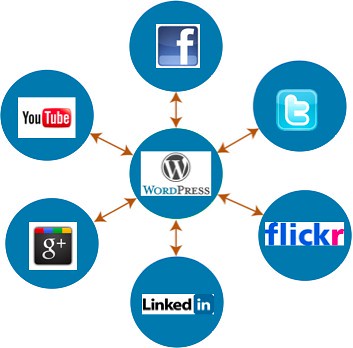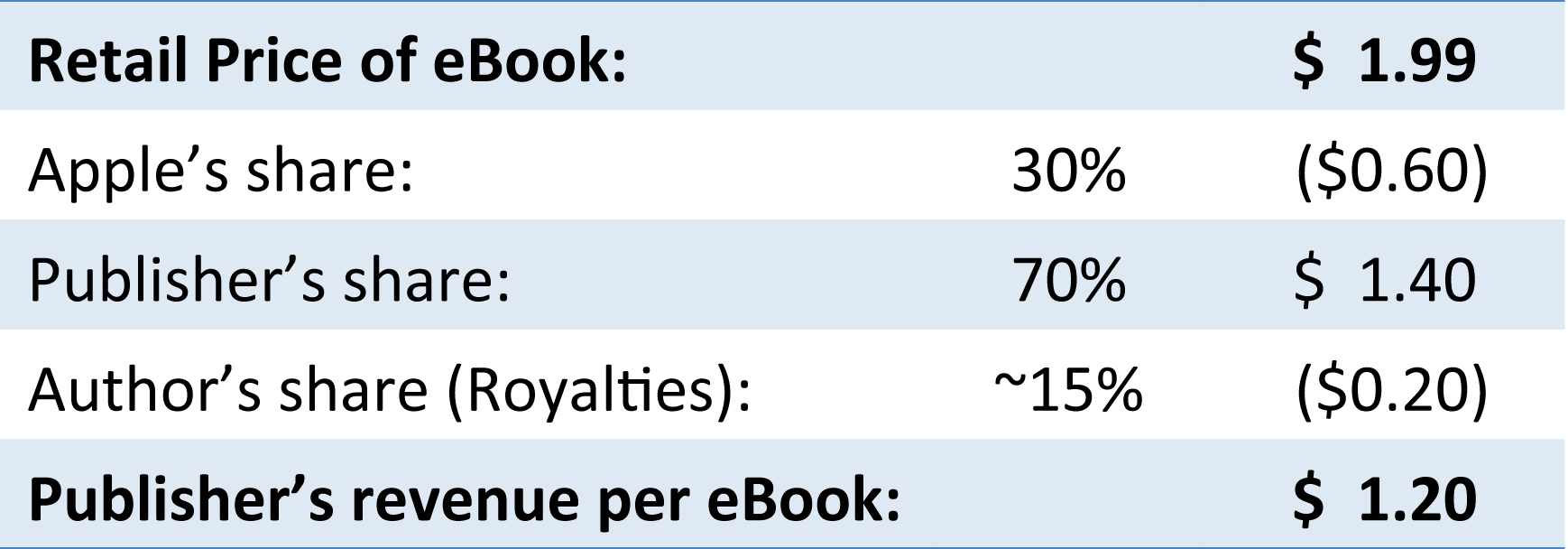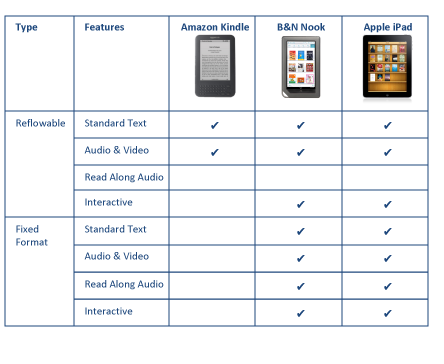 blog
blog
Why publishers should convert all their print-ready books to eBooks 0 comments
Publishers are sitting on valuable content. Assuming publishers have cleared distribution rights for the titles they own, we do not see any reason why publishers would not want to convert their assets to eBooks.
The logic behind our point-of-view is as follows. Let’s say converting an eBook costs $1,000 USD. Let’s say that a particular eBook title can be sold for $1.99 on the iBookstore. Since Apple collects 30% of each eBooks sale, publishers stand
to make $1.39 per book. With royalties between 8-15%, which is around $0.20 per book, publishers would still make at least $1.00 per book.
Based on the estimated revenue per book as stated above, the publisher needs to sell approximately 1,000 eBooks to cover the conversion cost of $1,000.
As of September 2011, Apple reported that 30 million iPads were sold worldwide.
The number of potential customers will only grow over time. Having an eBook for sale in a digital marketplace isn’t the same as selling a book in a traditional, physical marketplace. EBooks do not have a shelf-life, nor do they require reprints. Once it is available for sale, there are no additional costs to the publisher. Publishers should treat eBook conversion as their digital printer and without the risk of over estimating the number of prints, physical inventory and distribution costs and handling returns for credit.
Invogen understands the content and publishing value chain, and has been working with publishers since 2008 to develop digital strategies and provide cost-efficient solutions. We have developed a streamlined and cost-effective approach to converting print-ready books to eBooks for less than $1,000. Invogen has also been at the forefront of eBook conversion, and understands the intricacies of the task. We can turn around an eBook in less than two days to meet market expectations. Contact us if you have any questions about our Digital Publishing service offering.
Posted by gdu at 12:38 pm No commentsWhat are the different types of eBooks available? 0 comments
There are two types of
eBooks available in the market: reflowable and fixed format. Reflowable eBooks were first made available and commercialized by Amazon’s Kindle. Reflowable books generally contain a large amount of text and not many images. “Reflowable” means the text and images of the book will adjust based on screen size. Novels are the most popular form of reflowable eBooks.
Fixed format eBooks are primarily pictures. Unlike reflowable books, fixed format books are set and configured for a device at a specific size. Children’s books, cookbooks, and magazines are some examples of fixed format eBooks. A fixed format eBooks is a mirror image of the printed format on an electronic reading device (eReaders). Barnes & Noble’s Nook and Apple’s iPad are devices that supports fixed format eBooks. As of September 2011, Amazon’s Kindle does not support this feature. Hence you do not see many children’s books on the Kindle.
The chart below illustrates each eBook type and the features available with each eReader:
The second generation of eReaders provides support for enhanced eBooks. Enhanced eBooks contain additional features such as audio and video in addition to text. Publishers have been adding audio and video clips throughout eBooks to provide a different reading experience for eBook readers. By providing enhanced features, publishers sometimes charge more for the enhanced eBook.
Another enhanced eBook feature is “Read Along Audio.” “Read Along Audio” synchronizes an audio file with each word inside the eBook. When activated, the eReader automatically highlights words as they are read aloud by a narrator.
Most recently, publishers have added “Interactivity” to eBooks as another set of enhanced features. Newer eReaders, such as the Apple iPad 2, can render HTML5, CSS3 and Javascript. Publishers have used this opportunity to further engage readers with the book.
The most commonly-used interactive features include animation, sound effects, games, etc., that tie into the story.
Invogen has been advising major and independent publishers on eBook conversions since 2009. We have developed a streamlined and cost-efficient approach to converting print-ready books to eBooks. For more information,
please contact Garren Du or Paul Lee.
Posted by plee at 2:23 am No commentsHow to implement a successful social media strategy leveraging open source solutions 0 comments
Launching a successful social media presence should not require significant investment in capital, people or technology. The level of effort to implement the social media strategy should be driven by the initial investment in the product/website/business. If the product costs millions of dollars to produce, spend a percentage of that budget. There are cost effective ways to leverage social media regardless of the size of your marketing or technology budget. To successfully execute the strategy, make sure your organization has the operational processes in place to manage your ongoing communications efforts.
Social media should be intentions based like everything you do in life. You want to have social interactions that drive the audience and participants to your product or website so you can covert them into a customer or user. To be successful, you will need a hub and spoke strategy. Leverage the social media channels to carry out the message and have your hub clearly communicate your message when they arrive.

First, use the social media channels as “spokes” to engage discussions:
1. For your brand/business/product: register a domain if you have not done so already.
2. Use your Facebook account to create a Facebook Page for your product or business. Begin inviting your friends to “like” the pageand begin the discussion. Setup the Facebook Page to be enabled to import your blog posts or blogs related to your target audience. Consider adding the “Reviews” tab if you want to solicit reviews and candid feedback from your fans.
3. Create a Twitter account for your company or product if you have not already done so. Review Twitter discussions and identify trends related to your productor service offering. Begin to interact with other Twitter users and earn the community’s trust.
3a. If your product involves multimedia, setup a You Tube channel and Flickr album. Always upload your media to these sites to increase awareness and be found via organic search.
Now that the social media channels “spokes” are active, set up a website as a “hub” to communicate your messages:
1. Setup a website built on WordPress to serve as your communications hub. Here are the following reasons why WordPress is a great tool for this: WordPress is search engine friendly; easy to setup; has thousands of social media plugins meaning minimal programming to connect to Facebook, Twitter, etc.; out of the box syndication capabilities with RSS; built in SEO; and extremely easy to use from a business user perspective.
2. Configure WordPress to have the following plugins: Facebook Page, Twitter feeds and mentions, Flickr, YouTube, and whatever channel you wish to engage your discussions.
3. Use your website built on WordPress as a tool to create valuable content communicating directly to your prospective and existing customers. Properly categorize and apply appropriate tags to the content you’re publishing on the website/hub. Creating valuable content on a search engine friendly tool like WordPress will increase your page rank if you follow search engine marketing (SEM) best practices.
To complete the hub and spoke strategy, you will also want to make sure your content is syndicated to the proper social media channels and related websites. There are free tools available in the marketplace that allows you to send your WordPress post content via RSS to Facebook
and Twitter (i.e., TwitterFeed.com).
Finally, you should also make sure your content from the hub reaches content aggregation and news websites – other hubs where people go to view content. For example, Digg and Technorati. Submitting your blog post or company news to Digg furthers your content reach to your customers and prospects.
The simple steps described above can be easily implemented at a cost effective way. Developing a strategy and the plan is the easy part. Executing the plan and providing ongoing management of the message is the art to success.
For the past few years, Invogen has been developing and implementing social media and marketing strategies for its clients across many industries. Invogen has helped its clients launch new products, websites and brick and mortar businesses. Invogen can help your organization realize the marketing plan and goals, and provide ongoing support to your organization’s social media needs.
Posted by gdu at 8:08 am No commentsWhy technical architecture is important to your business 0 comments
Many business executives view applications as a commodity and just want applications built at the lowest cost possible. Offshore application project failures stem from the lack of a solid technical architecture. Our clients often ask us to reduce our rates, whether our proposals can be done with offshore resources, or why one of our competitor’s bids is x% lower than our recommended solution. Our answer is
the following analogy we often share with our clients:
 Application development is exactly like designing and building a house. In order for you to begin designing your dream house, you would need to know the type of house you want to build, such as a a 3,000 square foot, two floor Victorian style home with four bedrooms and three baths, and a furnished basement. Once you know what you want as a dream house, you’ll need to hire an architect to come up with the design, blueprint and define the foundation required to keep the house from falling apart when there’s a minor earthquake. You’ll also need to retain a general contractor to help oversee the building of your dream house.
Application development is exactly like designing and building a house. In order for you to begin designing your dream house, you would need to know the type of house you want to build, such as a a 3,000 square foot, two floor Victorian style home with four bedrooms and three baths, and a furnished basement. Once you know what you want as a dream house, you’ll need to hire an architect to come up with the design, blueprint and define the foundation required to keep the house from falling apart when there’s a minor earthquake. You’ll also need to retain a general contractor to help oversee the building of your dream house.
With the foundational design in hand, a general contractor will help you find and manage the electricians, plumbers, carpenters, etc to begin construction. During the construction of your dream house, you would keep your architect engaged to ensure the structures and beams are strong enough to prevent the house from collapsing. You will also expect the general contractor to keep you up to date with status reports, resolve open issues for you, and help you manage your budget and risks. Meanwhile, you’ll probably have minimum to no interaction with the plumbers, electricians, etc.
Upon completion of the dream house, you’ll probably want to have an interior and exterior designer to decorate your house based on your taste. Painting the room with a specific color, hanging up lamps, putting up the floor to ceiling curtains will probably not require a general contractor or an architect. However, aesthetic is what you are going to see and judge as the final product. Your dream house will receive a lot of complements as you host guests. The interior designer generally gets all the credit; but the work and effort from the architect to the plumber cannot be discounted. Applying the house building analogy to application development, the architect designing your house is the technical architect. The technical architect needs to ensure the application is designed properly and can scale as your business grows – i.e., your house will not fall apart when you have 30 guests on the second floor during your house warming or crumble when there’s a light tremor. Circling back to the original questions from our clients:
1. Can you build the application offshore?
Another way to ask this question is: can we build a house with low cost day laborers vs licensed electricians. The answer is yes, absolutely. However, you will still need an architect to
ensure the house has the proper structure, and a “done it all” general contractor to manage the project. No day laborer can replace a seasoned architect. Placing upfront investment in technical architecture ensures a solid foundation that can scale, so adding a balcony on the second floor of your Victorian a year later will have minimal impact to the structure of the house. Building an application without a strong project manager managing your offshore development effort is like having a general contractor who doesn’t understand electric circuits and wiring, or has never put up kitchen cabinets. The risk is extremely high when you send tasks offshore. Offshore developers are just like day laborers, they lack the understanding of the big picture and lack attention to details. A solid project manager will manage the risk of getting something back from your offshore team that does not meet 50% of your documented requirements.
2. Why is your competitor’s bid x% lower than yours?
Regardless if you’re designing and building a house or an application, the team is required to perform a list of tasks using a methodology. Invogen does not cut corners. We share our methodology with our clients and show them the level of effort required to complete the project. Invogen does not believe we Invogen offers both on shore and offshore development options to our clients and we explain the benefits and risks of each. Transparency is our service policy. As seasoned architects and project managers, our team has deployed worldclass applications for Fortune 100 companies for the past decade. Invogen is also trusted by our clients to support their mission critical applications 24×7.
For more information, contact Garren Du, Managing Director of Invogen at garren.du@invogen.com.
Posted by gdu at 8:27 pm No commentscategories
Popular Posts
news & events
- Invogen helps Practising Law Institute launch two social networking websites
- Invogen Launches Dean Foster Associates’ Japan CultureGuide on the Apple App Store
- Abbey Spanier Rodd & Abrams website relaunch
- Invogen launches Unimenu leveraging Invogen iPhone Solution
- Invogen launches iPhone Solution

